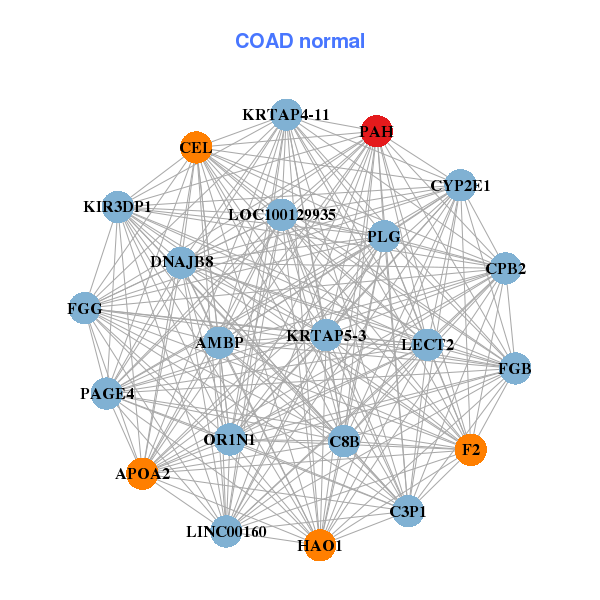|
||||||||||||||||||||
| |
| Phenotypic Information (metabolism pathway, cancer, disease, phenome) |
| |
| |
| Gene-Gene Network Information: Co-Expression Network, Interacting Genes & KEGG |
| |
|
| Gene Summary for PAH |
| Basic gene info. | Gene symbol | PAH |
| Gene name | phenylalanine hydroxylase | |
| Synonyms | PH|PKU|PKU1 | |
| Cytomap | UCSC genome browser: 12q22-q24.2 | |
| Genomic location | chr12 :103232103-103311381 | |
| Type of gene | protein-coding | |
| RefGenes | NM_000277.1, | |
| Ensembl id | ENSG00000171759 | |
| Description | phe-4-monooxygenasephenylalanine 4-monooxygenasephenylalanine-4-hydroxylase | |
| Modification date | 20141219 | |
| dbXrefs | MIM : 612349 | |
| HGNC : HGNC | ||
| Ensembl : ENSG00000171759 | ||
| HPRD : 08943 | ||
| Vega : OTTHUMG00000169966 | ||
| Protein | UniProt: P00439 go to UniProt's Cross Reference DB Table | |
| Expression | CleanEX: HS_PAH | |
| BioGPS: 5053 | ||
| Gene Expression Atlas: ENSG00000171759 | ||
| The Human Protein Atlas: ENSG00000171759 | ||
| Pathway | NCI Pathway Interaction Database: PAH | |
| KEGG: PAH | ||
| REACTOME: PAH | ||
| ConsensusPathDB | ||
| Pathway Commons: PAH | ||
| Metabolism | MetaCyc: PAH | |
| HUMANCyc: PAH | ||
| Regulation | Ensembl's Regulation: ENSG00000171759 | |
| miRBase: chr12 :103,232,103-103,311,381 | ||
| TargetScan: NM_000277 | ||
| cisRED: ENSG00000171759 | ||
| Context | iHOP: PAH | |
| cancer metabolism search in PubMed: PAH | ||
| UCL Cancer Institute: PAH | ||
| Assigned class in ccmGDB | A - This gene has a literature evidence and it belongs to cancer gene. | |
| References showing role of PAH in cancer cell metabolism | 1. Mantey JA, Rekhadevi PV, Diggs DL, Ramesh A (2014) Metabolism of benzo (a) pyrene by subcellular fractions of gastrointestinal (GI) tract and liver in Apc Min mouse model of colon cancer. Tumor Biology 35: 4929-4935. go to article | |
| Top |
| Phenotypic Information for PAH(metabolism pathway, cancer, disease, phenome) |
| Cancer | CGAP: PAH |
| Familial Cancer Database: PAH | |
| * This gene is included in those cancer gene databases. |
|
|
|
|
|
| . | ||||||||||||||
Oncogene 1 | Significant driver gene in | |||||||||||||||||||
| cf) number; DB name 1 Oncogene; http://nar.oxfordjournals.org/content/35/suppl_1/D721.long, 2 Tumor Suppressor gene; https://bioinfo.uth.edu/TSGene/, 3 Cancer Gene Census; http://www.nature.com/nrc/journal/v4/n3/abs/nrc1299.html, 4 CancerGenes; http://nar.oxfordjournals.org/content/35/suppl_1/D721.long, 5 Network of Cancer Gene; http://ncg.kcl.ac.uk/index.php, 1Therapeutic Vulnerabilities in Cancer; http://cbio.mskcc.org/cancergenomics/statius/ |
| KEGG_PHENYLALANINE_METABOLISM REACTOME_METABOLISM_OF_AMINO_ACIDS_AND_DERIVATIVES | |
| OMIM | 261600; phenotype. 612349; gene. |
| Orphanet | 2209; Maternal hyperphenylalaninemia. 293284; Tetrahydrobiopterin-responsive hyperphenylalaninemia/phenylketonuria. 79253; Mild phenylketonuria. 79254; Classical phenylketonuria. 79651; Mild hyperphenylalaninemia. |
| Disease | KEGG Disease: PAH |
| MedGen: PAH (Human Medical Genetics with Condition) | |
| ClinVar: PAH | |
| Phenotype | MGI: PAH (International Mouse Phenotyping Consortium) |
| PhenomicDB: PAH | |
| Mutations for PAH |
| * Under tables are showing count per each tissue to give us broad intuition about tissue specific mutation patterns.You can go to the detailed page for each mutation database's web site. |
| - Statistics for Tissue and Mutation type | Top |
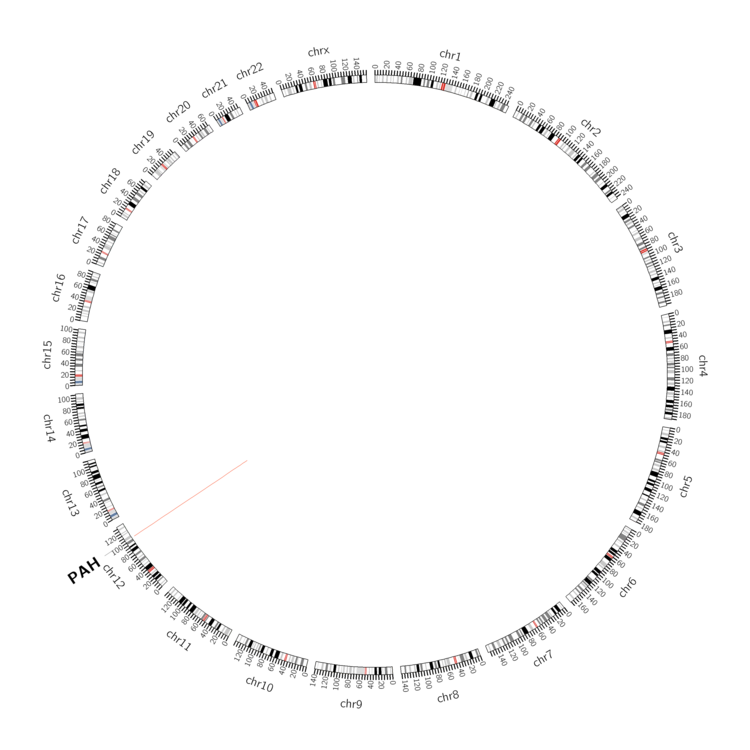 |
| - For Inter-chromosomal Variations |
| There's no inter-chromosomal structural variation. |
| - For Intra-chromosomal Variations |
| There's no intra-chromosomal structural variation. |
| Sample | Symbol_a | Chr_a | Start_a | End_a | Symbol_b | Chr_b | Start_b | End_b |
| pancreas | PAH | chr12 | 103278332 | 103278352 | PAH | chr12 | 103278467 | 103278487 |
| cf) Tissue number; Tissue name (1;Breast, 2;Central_nervous_system, 3;Haematopoietic_and_lymphoid_tissue, 4;Large_intestine, 5;Liver, 6;Lung, 7;Ovary, 8;Pancreas, 9;Prostate, 10;Skin, 11;Soft_tissue, 12;Upper_aerodigestive_tract) |
| * From mRNA Sanger sequences, Chitars2.0 arranged chimeric transcripts. This table shows PAH related fusion information. |
| ID | Head Gene | Tail Gene | Accession | Gene_a | qStart_a | qEnd_a | Chromosome_a | tStart_a | tEnd_a | Gene_a | qStart_a | qEnd_a | Chromosome_a | tStart_a | tEnd_a |
| Top |
| There's no copy number variation information in COSMIC data for this gene. |
| Top |
|
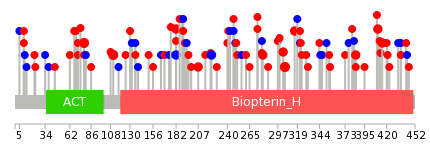 |
| Top |
| Stat. for Non-Synonymous SNVs (# total SNVs=63) | (# total SNVs=19) |
 | 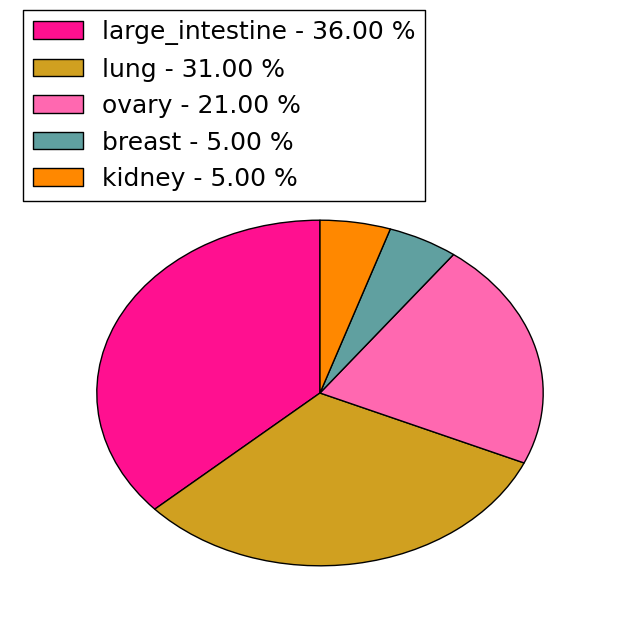 |
(# total SNVs=3) | (# total SNVs=0) |
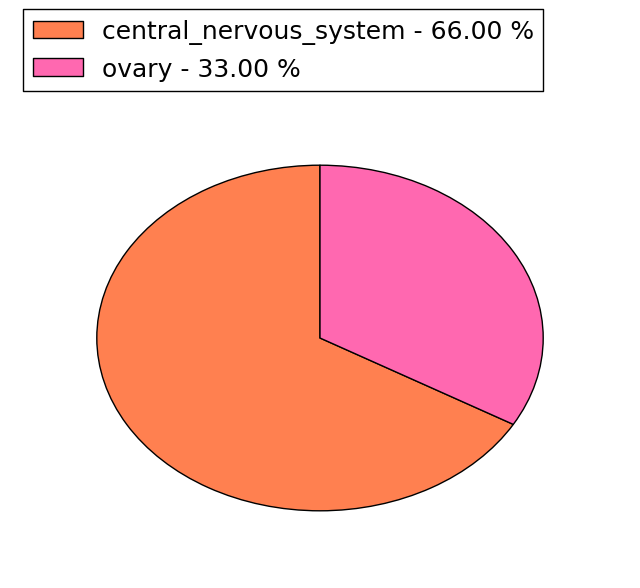 |
| Top |
| * When you move the cursor on each content, you can see more deailed mutation information on the Tooltip. Those are primary_site,primary_histology,mutation(aa),pubmedID. |
| GRCh37 position | Mutation(aa) | Unique sampleID count |
| chr12:103288633-103288633 | p.E78K | 3 |
| chr12:103240729-103240729 | p.E305K | 3 |
| chr12:103237469-103237469 | p.L385H | 3 |
| chr12:103288533-103288533 | p.R111Q | 3 |
| chr12:103240664-103240664 | p.? | 2 |
| chr12:103248954-103248954 | p.D222D | 2 |
| chr12:103234250-103234250 | p.D415N | 2 |
| chr12:103249074-103249074 | p.E182E | 2 |
| chr12:103249075-103249075 | p.E182G | 2 |
| chr12:103249000-103249000 | p.N207S | 2 |
| Top |
|
 |
| Point Mutation/ Tissue ID | 1 | 2 | 3 | 4 | 5 | 6 | 7 | 8 | 9 | 10 | 11 | 12 | 13 | 14 | 15 | 16 | 17 | 18 | 19 | 20 |
| # sample | 3 | 2 | 20 | 2 | 6 | 4 | 1 | 6 | 4 | 4 | 15 | 7 | 2 | |||||||
| # mutation | 3 | 2 | 21 | 2 | 6 | 4 | 1 | 7 | 4 | 4 | 15 | 7 | 2 | |||||||
| nonsynonymous SNV | 2 | 2 | 15 | 2 | 4 | 3 | 1 | 5 | 3 | 1 | 9 | 5 | 2 | |||||||
| synonymous SNV | 1 | 6 | 2 | 1 | 2 | 1 | 3 | 6 | 2 |
| cf) Tissue ID; Tissue type (1; BLCA[Bladder Urothelial Carcinoma], 2; BRCA[Breast invasive carcinoma], 3; CESC[Cervical squamous cell carcinoma and endocervical adenocarcinoma], 4; COAD[Colon adenocarcinoma], 5; GBM[Glioblastoma multiforme], 6; Glioma Low Grade, 7; HNSC[Head and Neck squamous cell carcinoma], 8; KICH[Kidney Chromophobe], 9; KIRC[Kidney renal clear cell carcinoma], 10; KIRP[Kidney renal papillary cell carcinoma], 11; LAML[Acute Myeloid Leukemia], 12; LUAD[Lung adenocarcinoma], 13; LUSC[Lung squamous cell carcinoma], 14; OV[Ovarian serous cystadenocarcinoma ], 15; PAAD[Pancreatic adenocarcinoma], 16; PRAD[Prostate adenocarcinoma], 17; SKCM[Skin Cutaneous Melanoma], 18:STAD[Stomach adenocarcinoma], 19:THCA[Thyroid carcinoma], 20:UCEC[Uterine Corpus Endometrial Carcinoma]) |
| Top |
| * We represented just top 10 SNVs. When you move the cursor on each content, you can see more deailed mutation information on the Tooltip. Those are primary_site, primary_histology, mutation(aa), pubmedID. |
| Genomic Position | Mutation(aa) | Unique sampleID count |
| chr12:103249074 | p.E182E | 3 |
| chr12:103288533 | p.R111Q | 3 |
| chr12:103246614 | p.K274T | 2 |
| chr12:103245469 | p.E182G | 2 |
| chr12:103249075 | p.S303F | 2 |
| chr12:103310881 | p.G10S | 2 |
| chr12:103240674 | p.F382L | 1 |
| chr12:103260388 | p.E286K | 1 |
| chr12:103288643 | p.V190V | 1 |
| chr12:103234267 | p.F80F | 1 |
| * Copy number data were extracted from TCGA using R package TCGA-Assembler. The URLs of all public data files on TCGA DCC data server were gathered on Jan-05-2015. Function ProcessCNAData in TCGA-Assembler package was used to obtain gene-level copy number value which is calculated as the average copy number of the genomic region of a gene. |
 |
| cf) Tissue ID[Tissue type]: BLCA[Bladder Urothelial Carcinoma], BRCA[Breast invasive carcinoma], CESC[Cervical squamous cell carcinoma and endocervical adenocarcinoma], COAD[Colon adenocarcinoma], GBM[Glioblastoma multiforme], Glioma Low Grade, HNSC[Head and Neck squamous cell carcinoma], KICH[Kidney Chromophobe], KIRC[Kidney renal clear cell carcinoma], KIRP[Kidney renal papillary cell carcinoma], LAML[Acute Myeloid Leukemia], LUAD[Lung adenocarcinoma], LUSC[Lung squamous cell carcinoma], OV[Ovarian serous cystadenocarcinoma ], PAAD[Pancreatic adenocarcinoma], PRAD[Prostate adenocarcinoma], SKCM[Skin Cutaneous Melanoma], STAD[Stomach adenocarcinoma], THCA[Thyroid carcinoma], UCEC[Uterine Corpus Endometrial Carcinoma] |
| Top |
| Gene Expression for PAH |
| * CCLE gene expression data were extracted from CCLE_Expression_Entrez_2012-10-18.res: Gene-centric RMA-normalized mRNA expression data. |
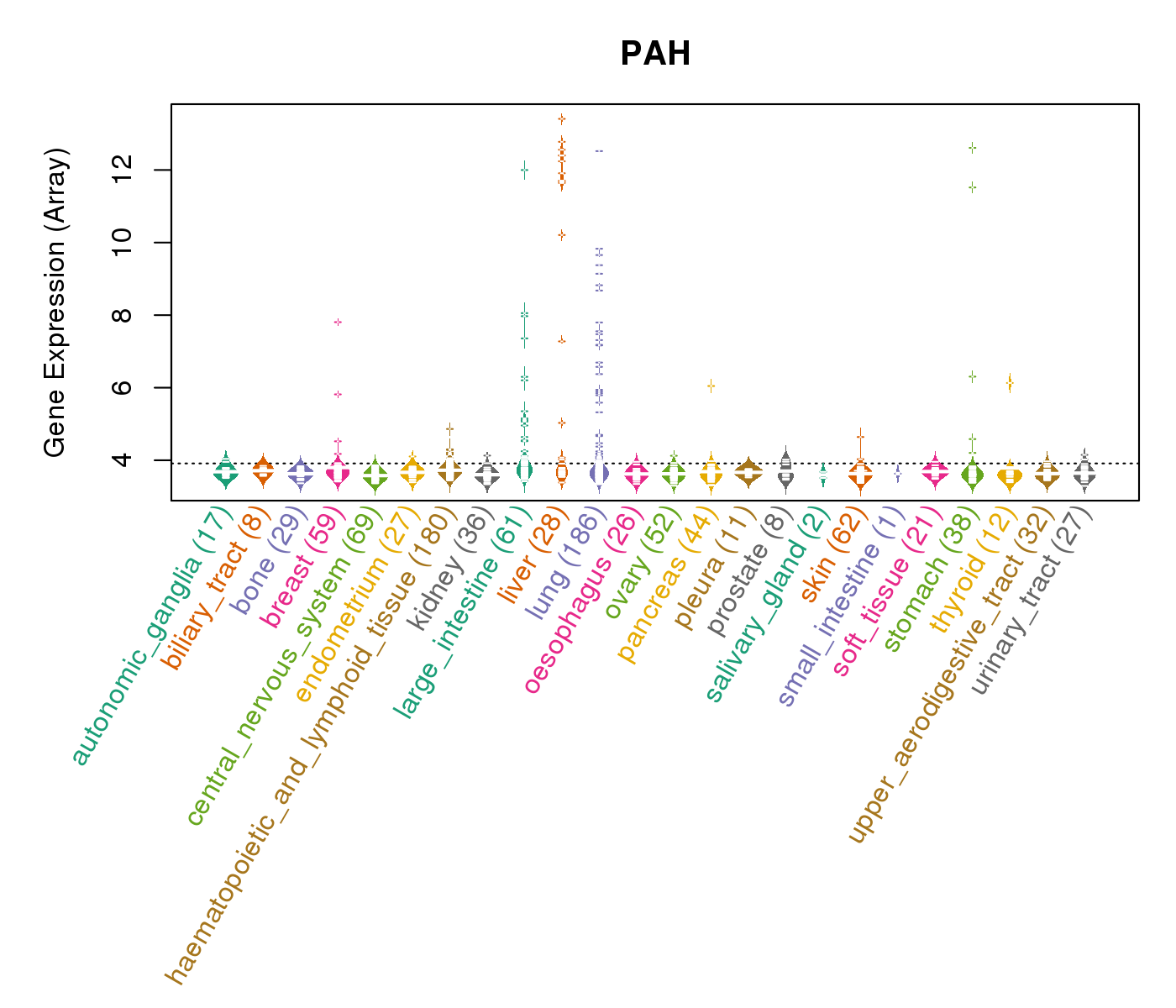 |
| * Normalized gene expression data of RNASeqV2 was extracted from TCGA using R package TCGA-Assembler. The URLs of all public data files on TCGA DCC data server were gathered at Jan-05-2015. Only eight cancer types have enough normal control samples for differential expression analysis. (t test, adjusted p<0.05 (using Benjamini-Hochberg FDR)) |
 |
| Top |
| * This plots show the correlation between CNV and gene expression. |
: Open all plots for all cancer types
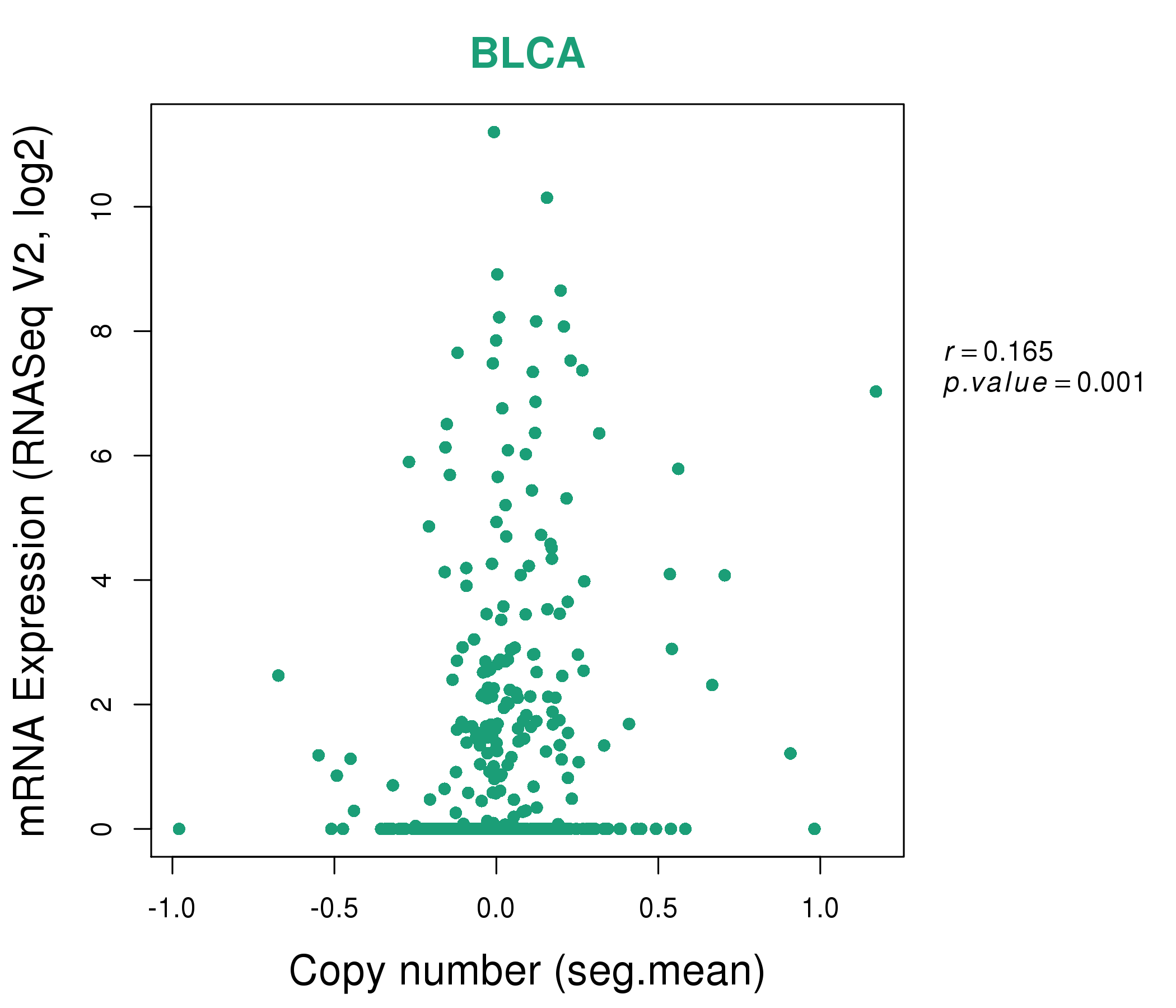 |
|
 |
|
| Top |
| Gene-Gene Network Information |
| * Co-Expression network figures were drawn using R package igraph. Only the top 20 genes with the highest correlations were shown. Red circle: input gene, orange circle: cell metabolism gene, sky circle: other gene |
: Open all plots for all cancer types
 |
| ||||
| AATK,ADARB2,ARSG,ASB16,BAIAP3,CCDC151,GDF15, GOLGA2P3Y,PAH,PSG10P,PSG4,PSG5,PSG6,PSG9, RTP2,SEMA3B,SLC16A6,TLX2,UNC5CL,VWA5B2,WNT3 | AK5,C1orf74,C3orf14,CD9,DKFZP586I1420,ERP27,FAAH2, HHAT,IRF6,KIF5C,LIPH,MYO6,PAH,PAK6, PLEKHA6,POF1B,SDC4,SHISA2,VAV3,VEPH1,WISP3 | ||||
 |
| ||||
| ADAMTS20,ALDH4A1,AMACR,CDH26,CT47A1,ENGASE,EYA1, MROH5,GCG,GRPR,ITGA2B,LOC340357,LOC541473,METAP1D, PAH,PMFBP1,QPRT,SLC5A6,VIL1,XAGE2,ZNRF3 | AMBP,APOA2,C3P1,C8B,CEL,CPB2,CYP2E1, DNAJB8,F2,FGB,FGG,HAO1,KIR3DP1,KRTAP4-11, KRTAP5-3,LECT2,LOC100129935,LINC00160,OR1N1,PAGE4,PAH, |
| * Co-Expression network figures were drawn using R package igraph. Only the top 20 genes with the highest correlations were shown. Red circle: input gene, orange circle: cell metabolism gene, sky circle: other gene |
: Open all plots for all cancer types
| Top |
: Open all interacting genes' information including KEGG pathway for all interacting genes from DAVID
| Top |
| Pharmacological Information for PAH |
| DB Category | DB Name | DB's ID and Url link |
| Chemistry | BindingDB | P00439; -. |
| Chemistry | ChEMBL | CHEMBL3076; -. |
| Chemistry | GuidetoPHARMACOLOGY | 1240; -. |
| Organism-specific databases | PharmGKB | PA32911; -. |
| Organism-specific databases | CTD | 5053; -. |
| * Gene Centered Interaction Network. |
 |
| * Drug Centered Interaction Network. |
| DrugBank ID | Target Name | Drug Groups | Generic Name | Drug Centered Network | Drug Structure |
| DB00120 | phenylalanine hydroxylase | approved; nutraceutical | L-Phenylalanine | 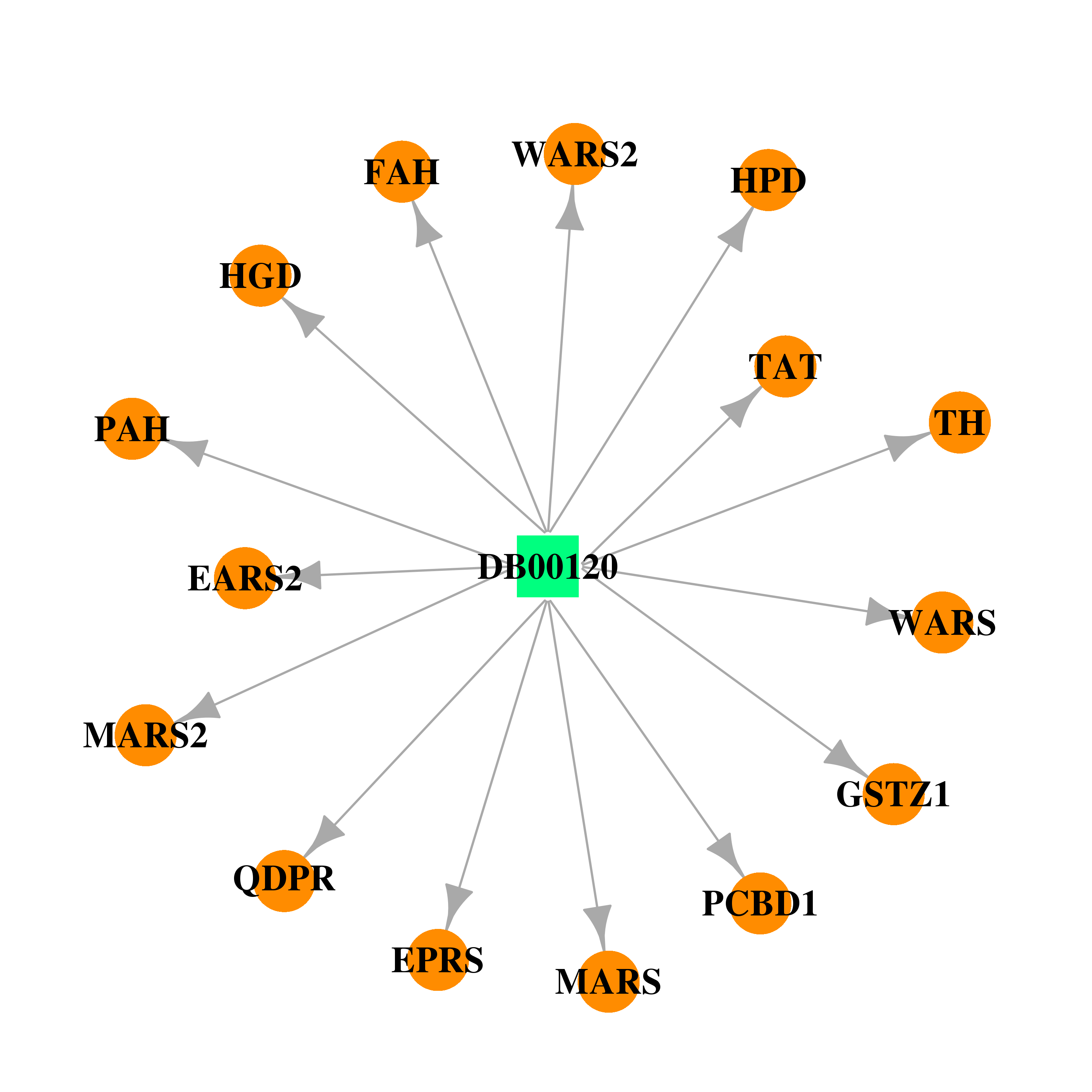 |  |
| DB00360 | phenylalanine hydroxylase | approved; investigational | Tetrahydrobiopterin | 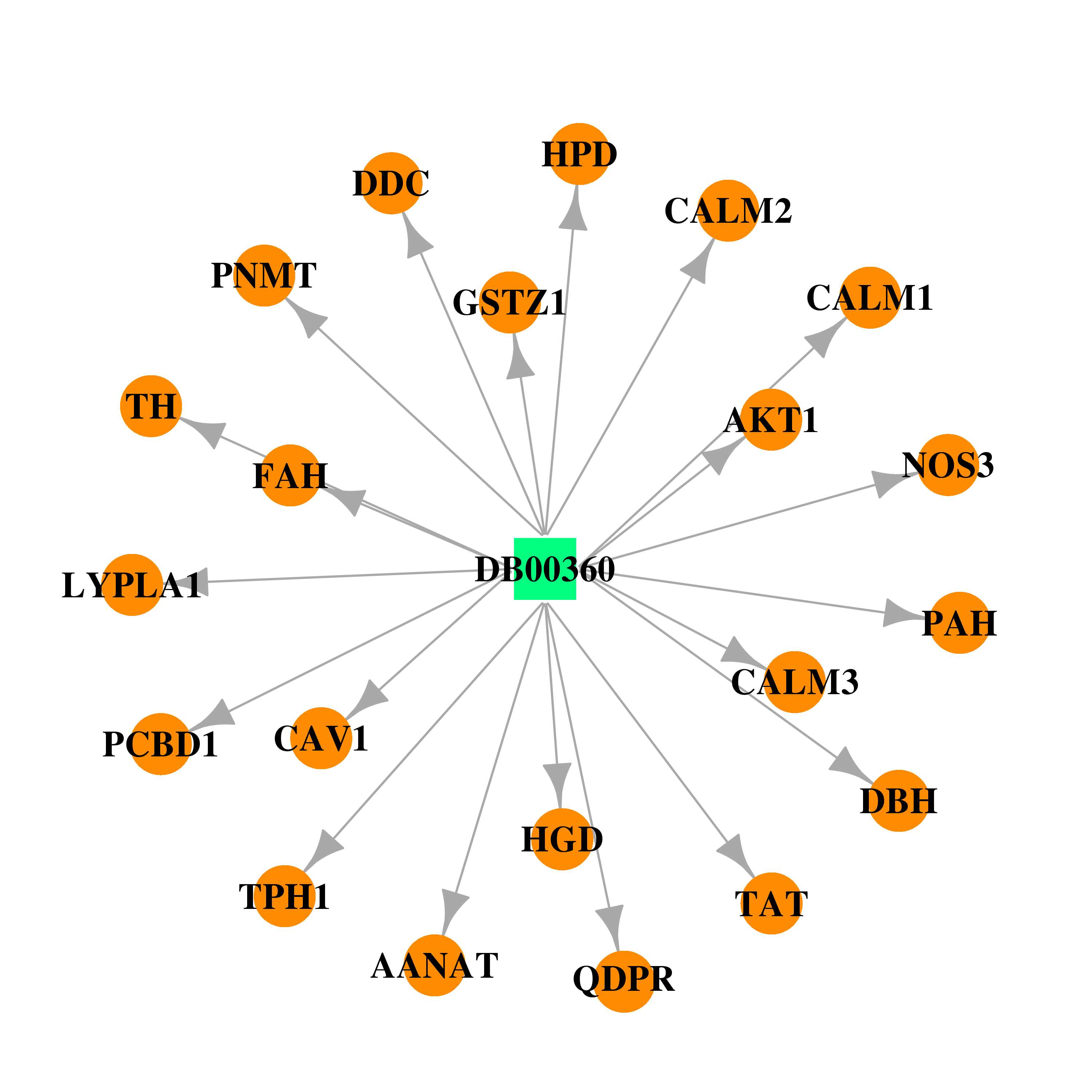 |  |
| DB00368 | phenylalanine hydroxylase | approved | Norepinephrine | 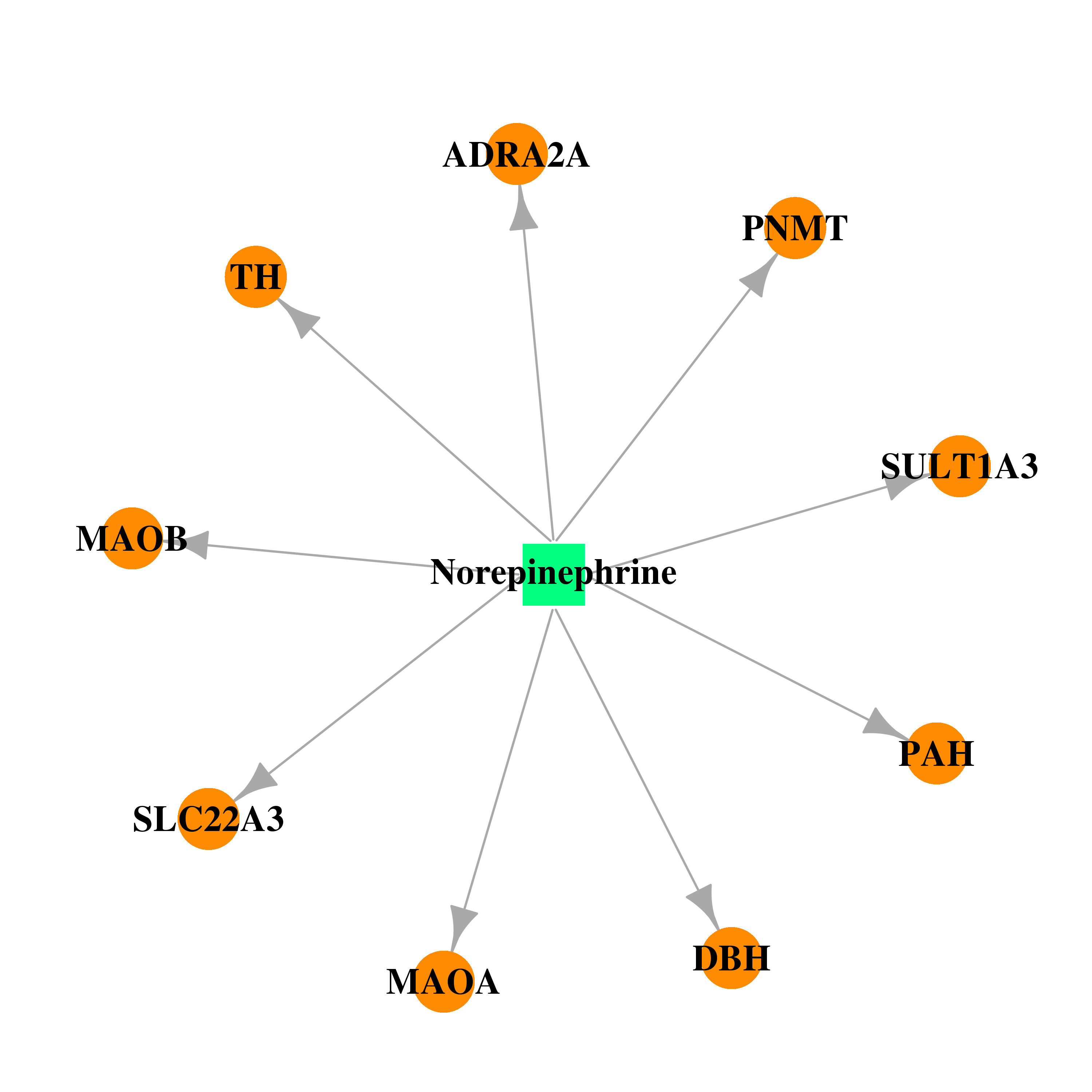 |  |
| DB00668 | phenylalanine hydroxylase | approved | Epinephrine |  |  |
| DB02562 | phenylalanine hydroxylase | experimental | Quinonoid 7,8-Tetrahydrobiopterin | 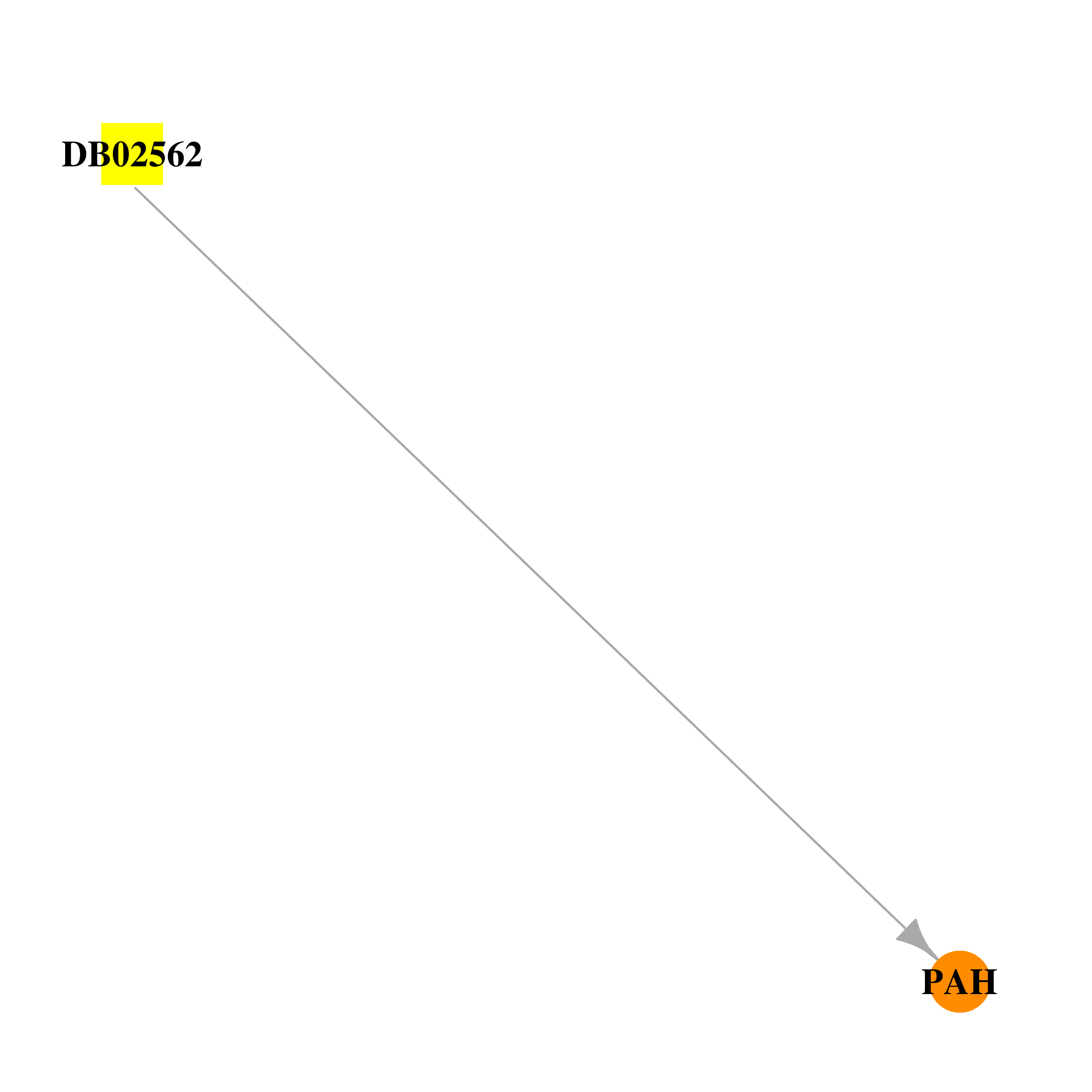 |  |
| DB02692 | phenylalanine hydroxylase | experimental | (6r,1'r,2's)-5,6,7,8 Tetrahydrobiopterin | 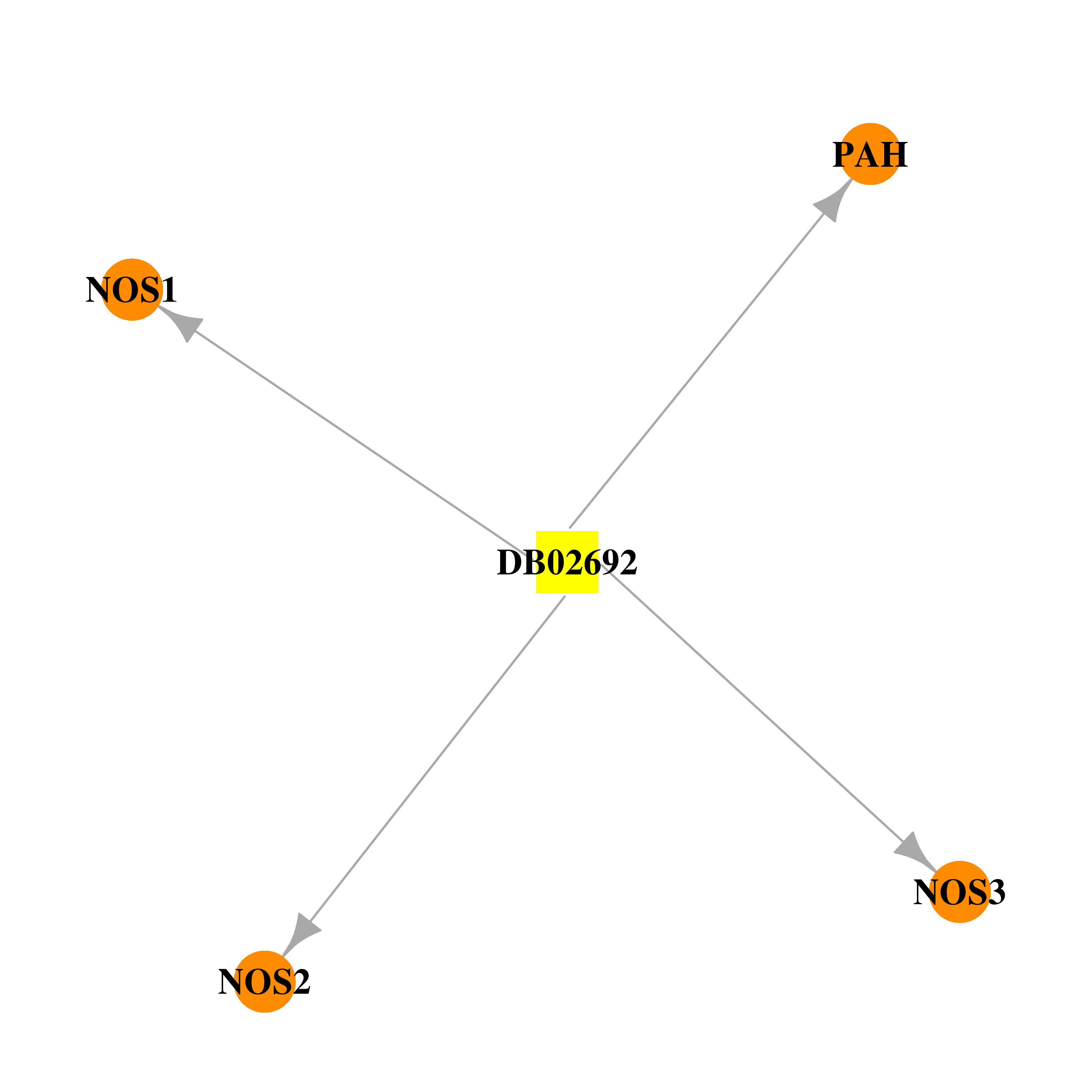 | 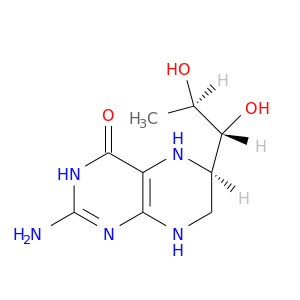 |
| DB03673 | phenylalanine hydroxylase | experimental | Beta(2-Thienyl)Alanine | 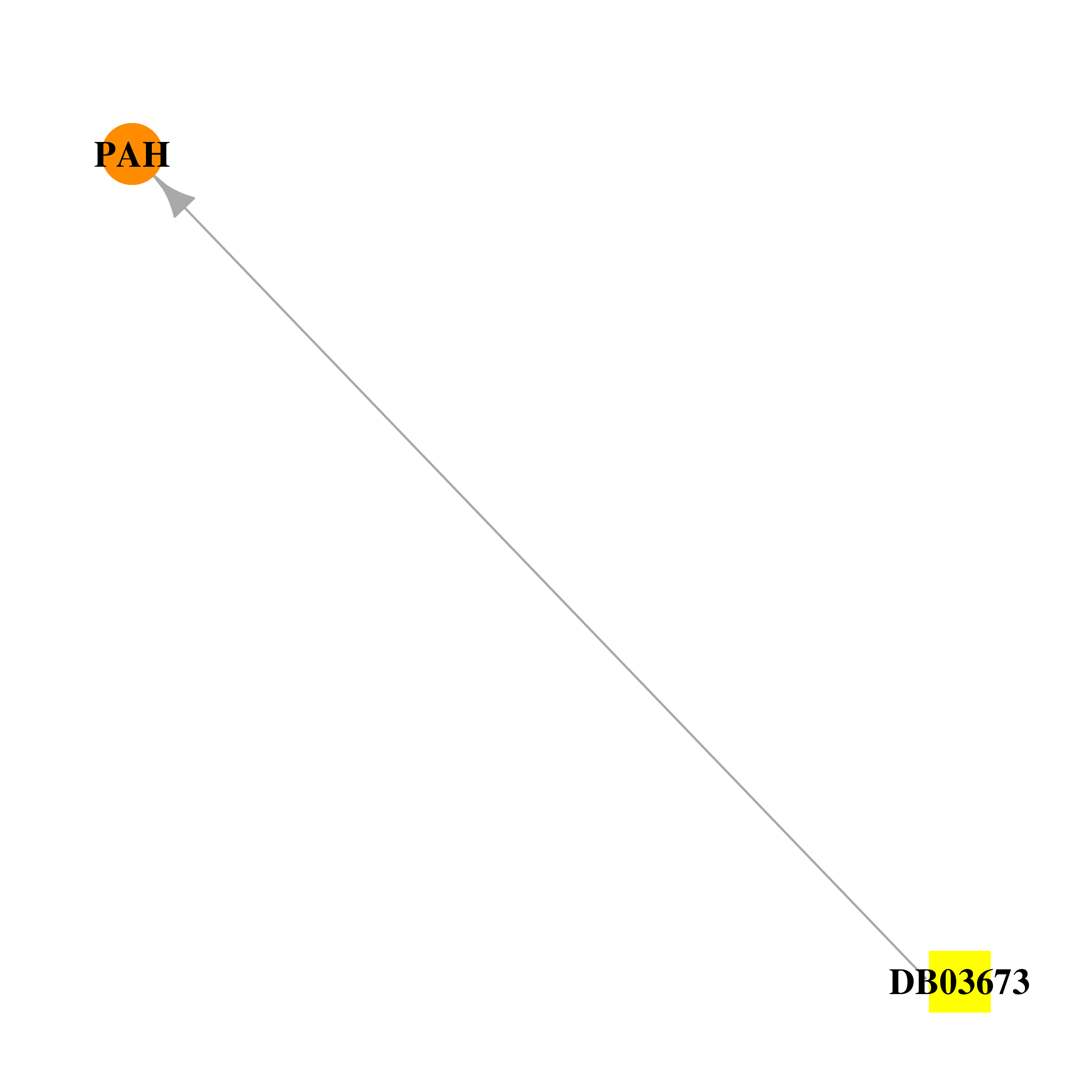 |  |
| DB04400 | phenylalanine hydroxylase | experimental | 7,8-Dihydrobiopterin |  | 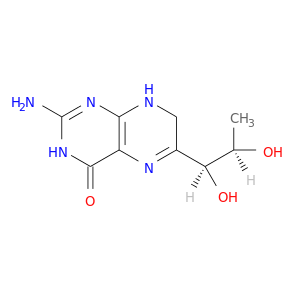 |
| DB04419 | phenylalanine hydroxylase | experimental | Norleucine |  | 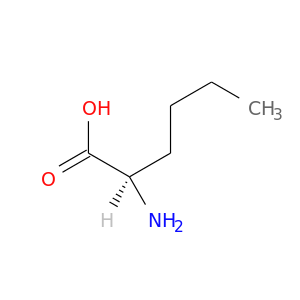 |
| DB06262 | phenylalanine hydroxylase | approved; investigational | Droxidopa | 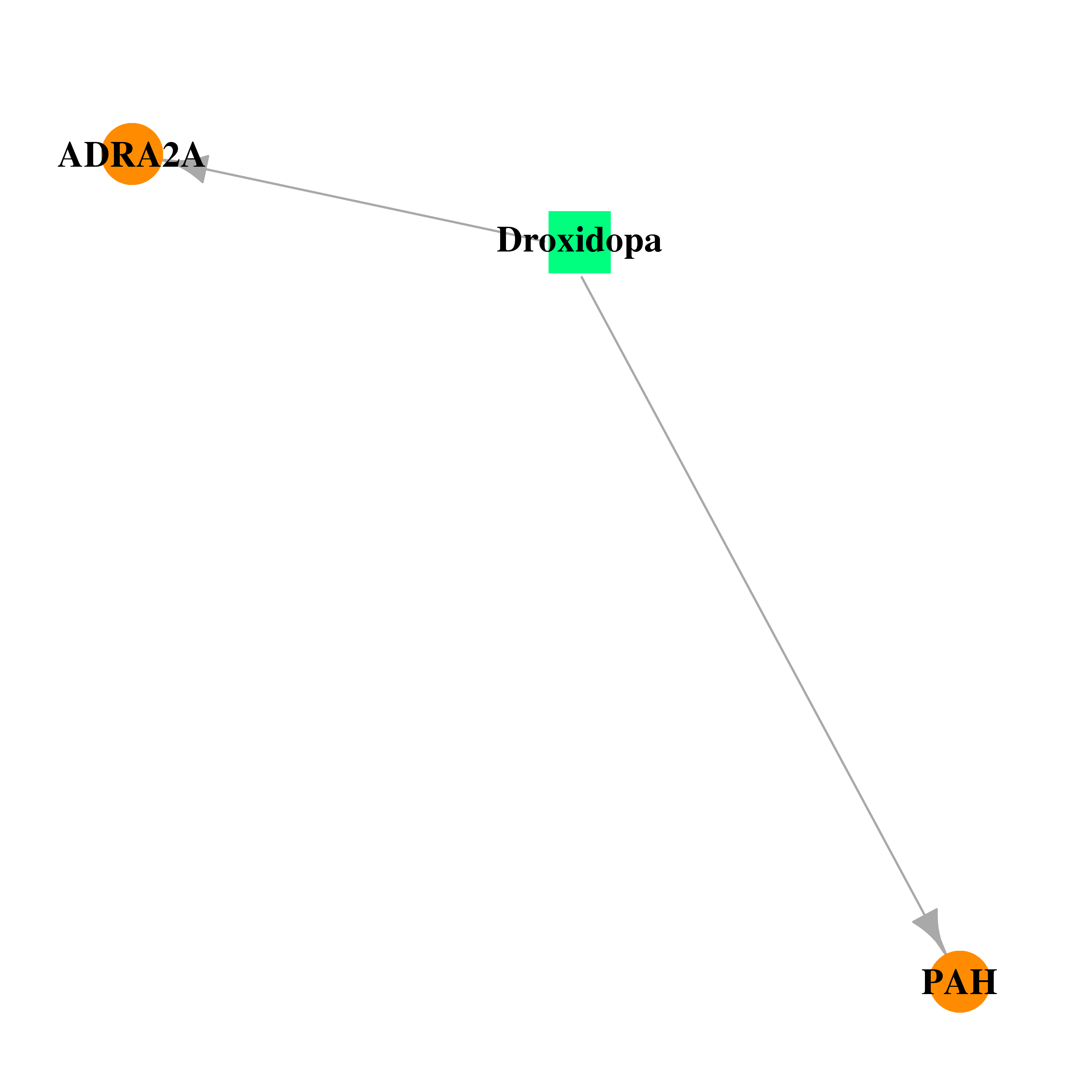 | 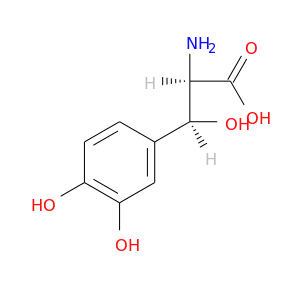 |
| DB03271 | phenylalanine hydroxylase | experimental | 7,8-Dihydro-L-Biopterin |  | 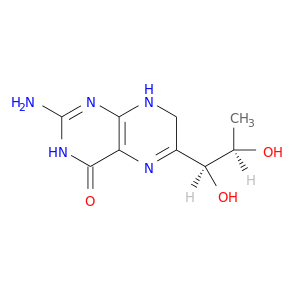 |
| DB00143 | phenylalanine hydroxylase | approved; nutraceutical | Glutathione |  |  |
| DB00135 | phenylalanine hydroxylase | approved; nutraceutical | L-Tyrosine |  | 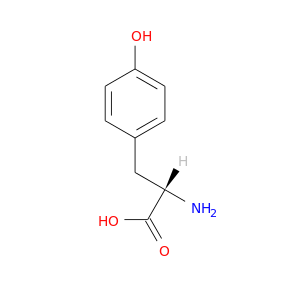 |
| Top |
| Cross referenced IDs for PAH |
| * We obtained these cross-references from Uniprot database. It covers 150 different DBs, 18 categories. http://www.uniprot.org/help/cross_references_section |
: Open all cross reference information
|
Copyright © 2016-Present - The Univsersity of Texas Health Science Center at Houston @ |









